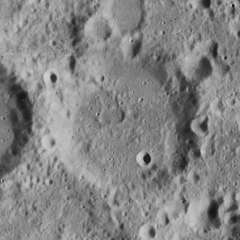Büsching (crater)
Büsching is a lunar impact crater that is located in the crater-covered southern highlands of the Moon. It was named after German geographer Anton F. Büsching.[1] The similar-sized crater Buch is located adjacent to its southwestern rim, and further to the southwest lies Maurolycus.
 Lunar Orbiter 4 image | |
| Coordinates | 38.0°S 20.0°E |
|---|---|
| Diameter | 52 km |
| Depth | 1.7 km |
| Colongitude | 343° at sunrise |
| Eponym | Anton F. Büsching |
This crater has been eroded by a long history of subsequent impacts, so that the rim has been worn down and the edge rounded. Several small craterlets lie along the edge of the rim, and there is a tiny crater on the interior floor near the east-southeastern rim. The interior floor is somewhat irregular and lacks a central peak at the midpoint.
Satellite craters
By convention these features are identified on lunar maps by placing the letter on the side of the crater midpoint that is closest to Büsching.
| Büsching | Latitude | Longitude | Diameter |
|---|---|---|---|
| A | 38.3° S | 20.4° E | 6 km |
| B | 39.0° S | 22.8° E | 17 km |
| C | 37.2° S | 19.6° E | 7 km |
| D | 38.6° S | 22.0° E | 33 km |
| E | 36.6° S | 18.4° E | 15 km |
| F | 39.0° S | 21.0° E | 6 km |
| G | 39.5° S | 21.6° E | 8 km |
| H | 37.4° S | 21.1° E | 5 km |
| J | 39.5° S | 22.2° E | 7 km |
| K | 37.9° S | 18.7° E | 5 km |
References
| Wikimedia Commons has media related to Büsching (crater). |
- "Büsching (crater)". Gazetteer of Planetary Nomenclature. USGS Astrogeology Research Program.
- Andersson, L. E.; Whitaker, E. A. (1982). NASA Catalogue of Lunar Nomenclature. NASA RP-1097.CS1 maint: ref=harv (link)
- Bussey, B.; Spudis, P. (2004). The Clementine Atlas of the Moon. New York: Cambridge University Press. ISBN 978-0-521-81528-4.CS1 maint: ref=harv (link)
- Cocks, Elijah E.; Cocks, Josiah C. (1995). Who's Who on the Moon: A Biographical Dictionary of Lunar Nomenclature. Tudor Publishers. ISBN 978-0-936389-27-1.CS1 maint: ref=harv (link)
- McDowell, Jonathan (July 15, 2007). "Lunar Nomenclature". Jonathan's Space Report. Retrieved 2007-10-24.CS1 maint: ref=harv (link)
- Menzel, D. H.; Minnaert, M.; Levin, B.; Dollfus, A.; Bell, B. (1971). "Report on Lunar Nomenclature by the Working Group of Commission 17 of the IAU". Space Science Reviews. 12 (2): 136–186. Bibcode:1971SSRv...12..136M. doi:10.1007/BF00171763.CS1 maint: ref=harv (link)
- Moore, Patrick (2001). On the Moon. Sterling Publishing Co. ISBN 978-0-304-35469-6.CS1 maint: ref=harv (link)
- Price, Fred W. (1988). The Moon Observer's Handbook. Cambridge University Press. ISBN 978-0-521-33500-3.CS1 maint: ref=harv (link)
- Rükl, Antonín (1990). Atlas of the Moon. Kalmbach Books. ISBN 978-0-913135-17-4.CS1 maint: ref=harv (link)
- Webb, Rev. T. W. (1962). Celestial Objects for Common Telescopes (6th revised ed.). Dover. ISBN 978-0-486-20917-3.CS1 maint: ref=harv (link)
- Whitaker, Ewen A. (1999). Mapping and Naming the Moon. Cambridge University Press. ISBN 978-0-521-62248-6.CS1 maint: ref=harv (link)
- Wlasuk, Peter T. (2000). Observing the Moon. Springer. ISBN 978-1-85233-193-1.CS1 maint: ref=harv (link)
